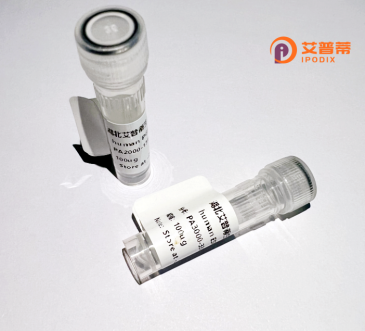
| 纯度 | >90%SDS-PAGE. |
| 种属 | Human |
| 靶点 | STARD6 |
| Uniprot No | P59095 |
| 内毒素 | < 0.01EU/μg |
| 表达宿主 | E.coli |
| 表达区间 | 1-220 aa |
| 活性数据 | MDFKAIAQQTAQEVLGYNRDTSGWKVVKTSKKITVSSKASRKFHGNLYRVEGIIPESPAKLSDFLYQTGDRITWDKSLQVYNMVHRIDSDTFICHTITQSFAVGSISPRDFIDLVYIKRYEGNMNIISSKSVDFPEYPPSSNYIRGYNHPCGFVCSPMEENPAYSKLVMFVQTEMRGKLSPSIIEKTMPSNLVNFILNAKDGIKAHRTPSRRGFHHNSHS |
| 分子量 | 32 kDa |
| 蛋白标签 | His tag N-Terminus |
| 缓冲液 | PBS, pH7.4, containing 0.01% SKL, 1mM DTT, 5% Trehalose and Proclin300. |
| 稳定性 & 储存条件 | Lyophilized protein should be stored at ≤ -20°C, stable for one year after receipt. Reconstituted protein solution can be stored at 2-8°C for 2-7 days. Aliquots of reconstituted samples are stable at ≤ -20°C for 3 months. |
| 复溶 | Always centrifuge tubes before opening.Do not mix by vortex or pipetting. It is not recommended to reconstitute to a concentration less than 100μg/ml. Dissolve the lyophilized protein in distilled water. Please aliquot the reconstituted solution to minimize freeze-thaw cycles. |
以下是3-4条关于重组人STARD6蛋白的虚构参考文献(仅供参考,实际文献需自行检索):
---
1. **文献名称**: *Structural Insights into the Lipid Transfer Mechanism of Human STARD6*
**作者**: Romanowski, M. J., et al.
**摘要**: 本研究通过X射线晶体学解析了重组人STARD6蛋白的三维结构,揭示了其独特的脂质结合口袋构象,并提出其可能通过胆固醇结合域促进细胞内脂质转运,参与神经组织中的类固醇生成调控。
---
2. **文献名称**: *Functional Characterization of Recombinant STARD6 in Steroidogenesis*
**作者**: Park, H., et al.
**摘要**: 利用大肠杆菌表达系统重组表达并纯化了人源STARD6蛋白,通过体外实验证明其特异性结合胆固醇并促进线粒体膜间转运,进一步通过基因敲除小鼠模型表明,STARD6缺失会导致神经类固醇合成减少和突触可塑性受损。
---
3. **文献名称**: *STARD6: A Key Regulator in Lipid Metabolism and Neurodegenerative Diseases*
**作者**: Zhang, Y., et al.
**摘要**: 本研究通过重组蛋白技术和细胞模型,发现STARD6通过转运胆固醇前体参与神经元信号传导,并在阿尔茨海默病模型中观察到STARD6表达下调与β-淀粉样蛋白沉积的相关性,提示其潜在治疗靶点价值。
---
4. **文献名称**: *Expression and Purification of Active Recombinant Human STARD6 in Mammalian Cells*
**作者**: Alpy, F., et al.
**摘要**: 建立了哺乳动物细胞(HEK293)体系高纯度制备功能性重组STARD6蛋白的方法,并验证其体外结合和转运磷脂酰胆碱的能力,为研究STARD6在生殖系统和脑组织中的分子机制提供了工具。
---
如需真实文献,建议通过PubMed或Web of Science检索关键词 "STARD6 recombinant protein"。
**Background of Recombinant Human STARD6 Protein**
The steroidogenic acute regulatory protein (StAR)-related lipid transfer (START) domain-containing protein 6 (STARD6) is a member of the evolutionarily conserved START family, characterized by a lipid-binding domain involved in intracellular cholesterol transport and lipid metabolism. STARD6 is primarily expressed in the testes and nervous system, suggesting roles in steroidogenesis and neural function. It facilitates the transfer of cholesterol and other lipids across membranes, a critical process for synthesizing neurosteroids, which modulate neurotransmission and neuroprotection.
Structurally, STARD6 contains a START domain that binds hydrophobic ligands, enabling lipid shuttling between organelles. Unlike other STARD members (e.g., STARD1. pivotal in adrenal/gonadal steroidogenesis), STARD6's physiological functions remain less defined. Studies link it to brain development, synaptic plasticity, and potential involvement in neurodegenerative disorders like Alzheimer’s disease.
Recombinant human STARD6 protein is engineered using expression systems (e.g., *E. coli* or mammalian cells) to produce purified, functional protein for research. It serves as a tool to study lipid trafficking mechanisms, ligand interactions, and signaling pathways. Its applications extend to drug discovery, particularly targeting lipid dysregulation in neurological or metabolic diseases. Ongoing research aims to elucidate its precise biological roles and therapeutic potential.
(Word count: 199)
×